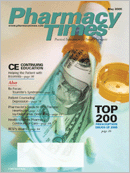Publication
Article
Pharmacy Times
Investigate Changes in Drug Appearance
Author(s):
As the number of generic products continues to increase, it seems that both patients and practitioners have become desensitized to changes in medication appearance?so much so that patients may not question a change, or, when they do, practitioners may simply reassure them that it was due to a change in manufacturer, without actively investigating the reason. It is not uncommon for the Institute for Safe Medication Practices (ISMP) to receive reports from both practitioners and consumers where a change in medication appearance was not fully investigated and subsequently contributed to an error.
In one case, a man shared an account of what his 86-year-old father experienced over the course of 9 days after his prescription for minoxidil was mistakenly refilled with another medication. The father had been taking minoxidil 2.5 mg for years at a dose of 5 mg (2 tablets) twice daily. Due to failing vision, he did not realize that his latest tablets looked different. His daughter noticed the change but was unconcerned, because the tablets had previously changed appearance.
Within a few days of taking the medication, the man's appetite began to fade, he complained of a sore throat, and he felt as if he was coming down with a cold. Soon after, he developed a red rash on his face, had trouble maintaining his balance, needed assistance with his daily activities, and wished to remain in bed. When a family friend, who happened to be a nurse, came to see him, she noticed a very red, raised rash on his abdomen that looked like a medication rash. She asked his daughter whether he was taking any new medications. She was informed that there were no new medications, but the minoxidil tablets looked different than before.
The pharmacy was contacted about the change. A staff member explained that it was a different generic for minoxidil and that the pills could be exchanged for those that he usually received. There was no mention of a mistake being made when the medication was exchanged. He was taken to the hospital the following day, when he could barely walk.
After this incident was explained to hospital staff, they contacted the pharmacy. It was then revealed that the patient had been given methotrexate by mistake, because the stock bottles were stored next to each other on the pharmacy shelf. By this time, the man had taken 36 methotrexate 2.5 mg tablets. His white blood cell and platelet counts were extremely low, and he was in critical condition. We at ISMP later learned that he passed away during that hospital visit.
In another case, a breast cancer patient went to her pharmacy to pick up a refill for letrozole (Femara; an antiestrogen drug) but instead received the estrogenreplacement product norethindrone acetate/ethinyl estradiol (Femhrt). The patient recognized that the tablets were different. After she read the label on the prescription bottle, which indicated Femara, however, she proceeded to take the tablets, thinking that the pharmacy had used another manufacturer's product. After some time, she began to experience bloating, low back pain, and menstrual spotting.
The error was discovered when she was seen in the clinic and the practitioner asked to see her medication. It is believed that disease progression had occurred secondary to the estrogen exposure, as evidenced by increased tumor markers. As a result of the error, chemotherapy was restarted.
The nature of these errors reinforces the need for the prescription-verification process to be standardized. Verification should include comparisons of the pharmacy label with the selected manufacturer's product and the original prescription (whenever possible). In addition, the National Drug Code (NDC) number on the manufacturer's product should be compared with the NDC number in the pharmacy computer system. Pharmacies that utilize drug-imaging technology or barcode scanners as part of their verification process should experience fewer of these errors.
Patients should be made aware of what their medication will look like, and they should be educated to always question any change in its appearance. Pharmacies could consider software that allows a description of the medication's appearance to be printed on either the pharmacy label or the receipt. Staff members and patients should then be educated about proper use of this method.
Pharmacists should thoroughly investigate questions raised by patients or caregivers. Consider making it mandatory for pharmacists to investigate all inquiries related to changes in medication appearance. Although an auxiliary label can be placed on the medication container or the pharmacy receipt to alert the patient or caregiver that a change in appearance has occurred, the label may go unnoticed.
Dr. Kelly is the editor of ISMP Medication Safety Alert! Community/Ambulatory Care Edition.







